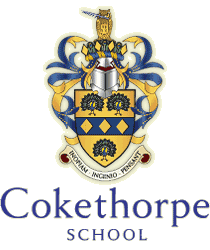Cokethorpe School
 | |
| Motto | Inopiam Ingenio Pensant |
|---|---|
| Established | 1957 |
| Type | Independent Day School |
| Religion | Church of England and Roman Catholic |
| Headmaster | Damian Ettinger |
| Chairman of Governors | Sir John Allison |
| Location |
Witney Oxfordshire OX29 7PU England |
| Students | about 660 |
| Gender |
Boys until 1992 Coeducational from 1992 |
| Ages | 4–18 |
| Houses | Feilden, Gascoigne, Harcourt, Queen Anne, Swift, Vanbrugh and Lower house |
| Colours | Navy Blue and Gold |
| Publication | The Ocellus |
| Former Pupils | The Cokethorpe Society |
| Setting | Rural (150 acres) |
| Website | Cokethorpe School |
Cokethorpe School is an independent school at Hardwick, West Oxfordshire, about 2.5 miles (4 km) south of Witney. It was founded in 1957 by Francis Brown.[1] It is a member of HMC, IAPS and The Society of Heads (formerly known as SHMIS). The school has about 660 pupils, ranging in age from four to 18. The Junior School and the Senior School are on the same site.

At the heart of the school is an early 18th-century Grade II* listed Queen Anne style country house.[2] The school is set in 150 acres (1 km2) of parkland and there is also a chapel in the grounds. The tower of the chapel was virtually destroyed in a fire in 1994 but it has since been demolished and rebuilt. The grounds have a number of rugby/football pitches along with the recently built astro pitches. An expertly carved 'giant' peacock stands at the central crossroads within the school grounds, a symbol of the school.
The school has an outstanding recent sporting tradition with students playing national age group rugby (England under-16 & under-18) and also England women's hockey. The school also has numerous representatives in both regional and Oxfordshire rugby, football, cricket, hockey, athletics and tennis. Also the school has developed a reputation as a premier kayaking school as well as nurturing equestrian talents.
The school operates a house system, with houses called Harcourt, Gascoigne, Swift, Queen Anne, Vanbrugh and Feilden. The houses compete in sport such as house rugby and football for boys, hockey and netball for girls, and in field and track events at the annual school sports day. There are also competitions in the arts, such as house music, drama, photography and art.
History
The country house was used by Simon Harcourt, 1st Viscount Harcourt.[3] When Major Percy Henry Guy Feilden and his wife, Dorothy Louisa Brand, moved there in 1908, they undertook extensive renovations.[4] He died on 25 March 1944, and was buried there.[5] His son, Major-General Randle Guy Feilden, who was later knighted, was his successor. In 1957, it was let with part of the grounds to Francis Brown, who opened the school as a secondary boys' boarding school with 14 pupils. In about 1960 Yarnton Manor was used as a dormitory of the school.[6] In 1963 a charitable trust was formed, and in 1966 the school buildings and grounds were sold to the school trustees.[1][3]

The school is a joint Church of England and Roman Catholic foundation.[7] The chapel is on the golf course in the school grounds. It is the former parish church of Hardwick, and was restored and extended in 1973.
In 1985 the roof of the north-west wing was studied while the building was being repaired.[8] In 1986 work began on the construction of further buildings. The school started admitting girls in 1992 and opened a junior school in 1994. The boarding facility was closed in 2003.
The school has developed a strong reputation in recent years with its improving exam results and outstanding sporting achievements. This has led to the school being over-subscribed, bucking the trend of many of its local competitors who have seen numbers fall.
Notable former pupils
- Martin Edwards, a former Manchester United chairman
- Tony Martin, an English farmer who was imprisoned for fatally shooting a burglar
- Richard and Michael Hills, twins and both successful flat racing jockeys in the UK.
References
- ↑ 1.0 1.1 Crossley, Alan; Currie, C.R.J. (eds.); Baggs, A.P.; Chance, Eleanor; Colvin, Christina; Day, C.J.; Selwyn, Nesta; Townley, Simon C. (1996). A History of the County of Oxford. 13: Bampton Hundred (Part One). pp. 110–118. ISBN 978-0-19722-790-9. Retrieved 27 January 2012.
- ↑ Historic England. "Cokethorpe School (Grade II*) (1048970)". National Heritage List for England. Retrieved 7 June 2014.
- ↑ 3.0 3.1 "Cokethorpe School, Oxfordshire". Venues. Remotegoat. Retrieved 27 January 2012.
- ↑ Jenkins, Stephanie (3 January 2012). "People of Headington: Katharine Feilden". Headington, Oxford. Stephanie Jenkins. Retrieved 27 January 2012.
- ↑ Jeffery, Zoe. "Percy Henry Guy Feilden (b. - 1944)". Records. Geni. Retrieved 27 January 2012.
- ↑ Crossley, Alan; Elrington, C.R. (eds.); Baggs, A.P.; Blair, W.J.; Chance, Eleanor; Colvin, Christina; Cooper, Janet; Day, C.J.; Selwyn, Nesta; Townley, Simon C. (1990). A History of the County of Oxford. Victoria County History. 12: Wootton Hundred (South) including Woodstock. pp. 475–478. ISBN 978-0-19722-774-9. Retrieved 3 February 2012.
- ↑ "Pastoral Care". Cokethorpe School. Retrieved 12 October 2014.
- ↑ Steane, John (1986). "Cokethorpe Park (PRN 11202 SP 37100620)" (PDF). The Newsletter of the Council for British Archaeology Regional Group 9 (Bedfordshire, Buckinghamshire, Northamptonshire, Oxfordshire) (The Council for British Archaeology) (16). Retrieved 3 February 2012.